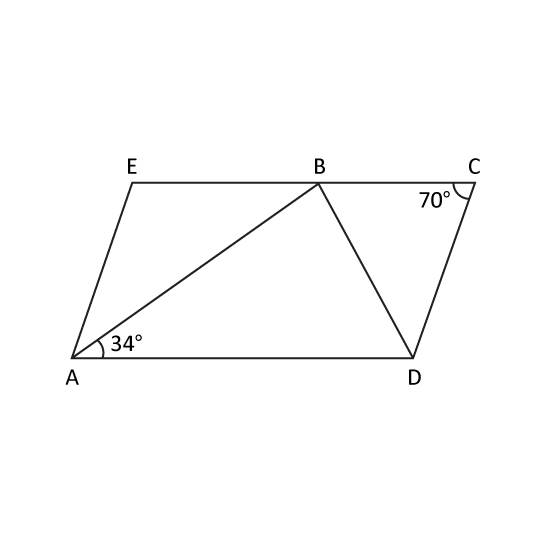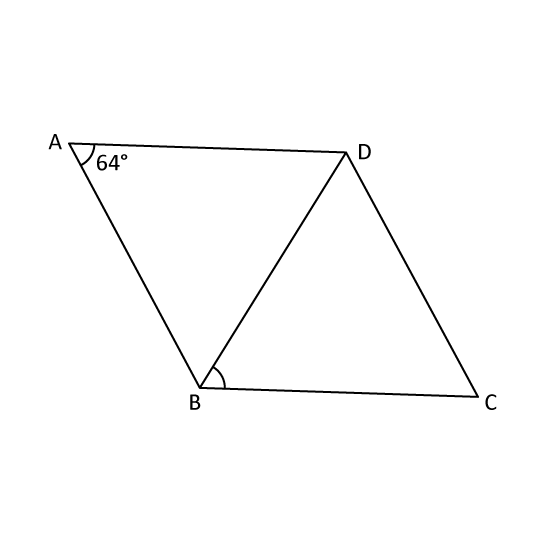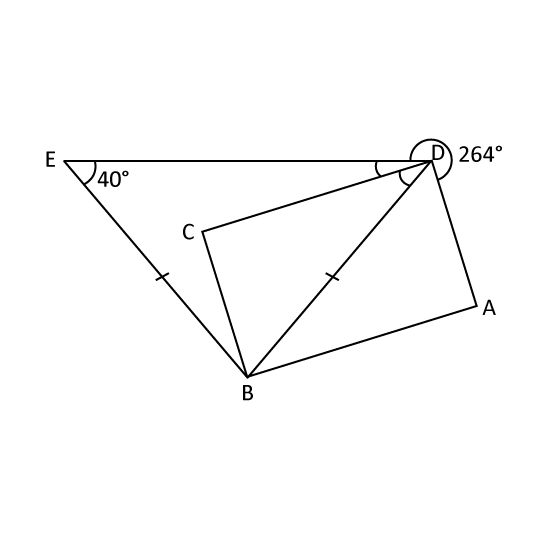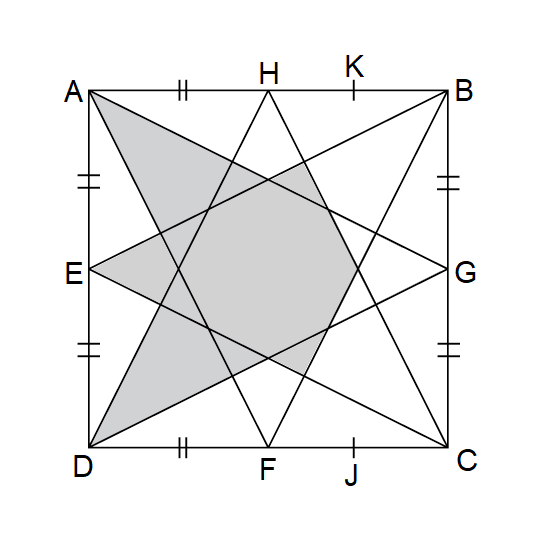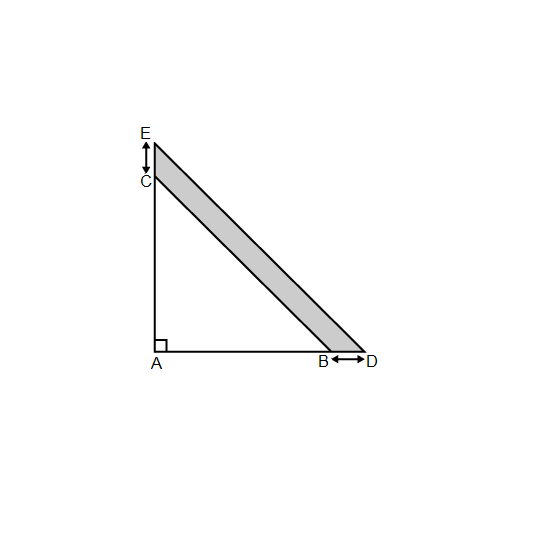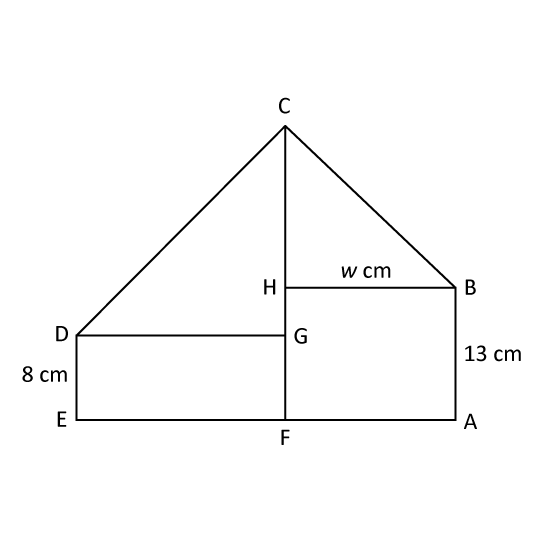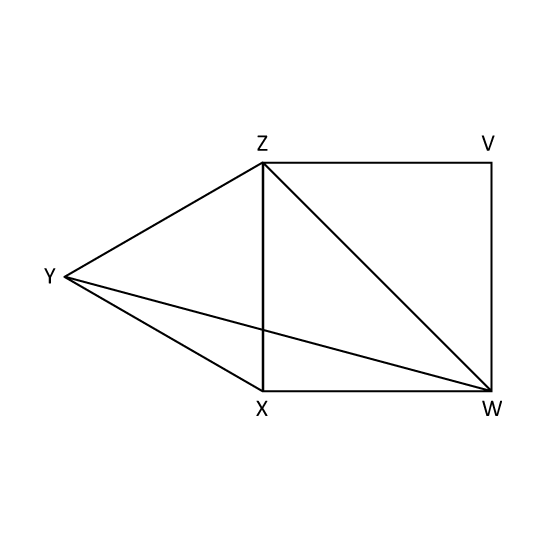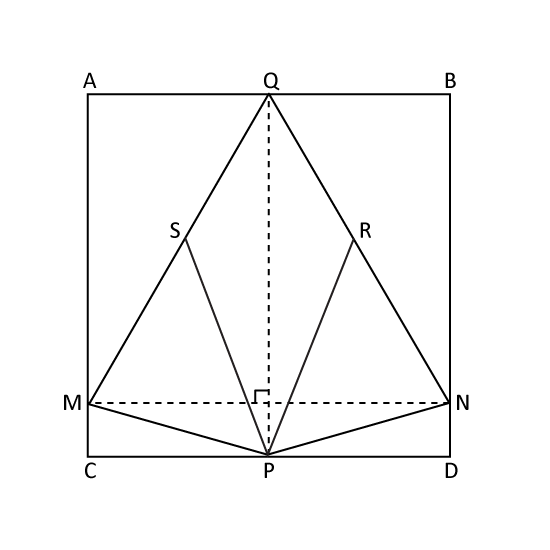Level 2 PSLE
ABCD is a trapezium, EA = EB and CBE is a straight line. Find ∠AEB.
Level 2 PSLE
ABCD is a trapezium, EA = EB and CBE is a straight line. Find ∠AEB.
Image in this question is not available.
Level 2 PSLE
ABCD is a trapezium with AB parallel to DC and AB = BC = BD.
Find ∠CBD.
Level 2 PSLE
ABCD is a trapezium with AB parallel to DC and AB = BC = BD.
Find ∠CBD.
Image in this question is not available.
Level 2 PSLE
In the figure, ABCD is a rectangle. BD = BE, ∠BED = 40° and ∠EDA = 264°. Find ∠CDB.
Level 2 PSLE
In the figure, ABCD is a rectangle. BD = BE, ∠BED = 40° and ∠EDA = 264°. Find ∠CDB.
Image in this question is not available.
Level 2
The figure is formed using four identical isosceles triangles. AGD, AFB, BEC and CHD. ABCD is a square where E, F, G and H are midpoints of its sides. Given FJ = CJ, HK = BK and AD = 14 cm, find the total area of the shaded parts.
Level 2
The figure is formed using four identical isosceles triangles. AGD, AFB, BEC and CHD. ABCD is a square where E, F, G and H are midpoints of its sides. Given FJ = CJ, HK = BK and AD = 14 cm, find the total area of the shaded parts.
Image in this question is not available.
Level 2
The figure is formed by a circle and an isosceles triangle where PQ = PR. The radius of the circle is 14 cm. Find the area of the shaded part. (Take π = 227)
Level 2
The figure is formed by a circle and an isosceles triangle where PQ = PR. The radius of the circle is 14 cm. Find the area of the shaded part. (Take π = 227)
Image in this question is not available.
Level 3
In the figure, ABC and ADE are right-angled isosceles triangles. BD = CE = 2 cm. The shaded area is 22 cm2. Find the length of AC.
Level 3
In the figure, ABC and ADE are right-angled isosceles triangles. BD = CE = 2 cm. The shaded area is 22 cm2. Find the length of AC.
Image in this question is not available.
Level 3 PSLEThe figure is made up of two rectangles, ABHF and FGDE, and two right-angled isosceles triangles, BCH and DCG. BA = 13 cm, DE = 8 cm and BH = w cm. AFE and CHGF are straight lines.
- Find the length of AE in terms of w. Give your answer in the simplest form.
- Find the total area of the figure when w = 16.
Level 3 PSLEThe figure is made up of two rectangles, ABHF and FGDE, and two right-angled isosceles triangles, BCH and DCG. BA = 13 cm, DE = 8 cm and BH = w cm. AFE and CHGF are straight lines.
- Find the length of AE in terms of w. Give your answer in the simplest form.
- Find the total area of the figure when w = 16.
Image in this question is not available.
Level 3
ABCD is a square. QPC and BPD are straight lines. BA = BQ and ∠PBQ = 13°. Find
- ∠BAQ
- ∠DCQ
.
Level 3
ABCD is a square. QPC and BPD are straight lines. BA = BQ and ∠PBQ = 13°. Find
- ∠BAQ
- ∠DCQ
.
Image in this question is not available.
Level 3 PSLE
In the figure, WXZV is a square, XY = XW and XYZ is an equilateral triangle. Find ∠YWZ.
Level 3 PSLE
In the figure, WXZV is a square, XY = XW and XYZ is an equilateral triangle. Find ∠YWZ.
Image in this question is not available.
Level 3
In the figure, ABDC is a square and QM = QP = QN. Given that RP = PS, RPN = 50° and MN is parallel to AB and it is perpendicular to PQ. Find ∠RPS.
Level 3
In the figure, ABDC is a square and QM = QP = QN. Given that RP = PS, RPN = 50° and MN is parallel to AB and it is perpendicular to PQ. Find ∠RPS.
Image in this question is not available.
